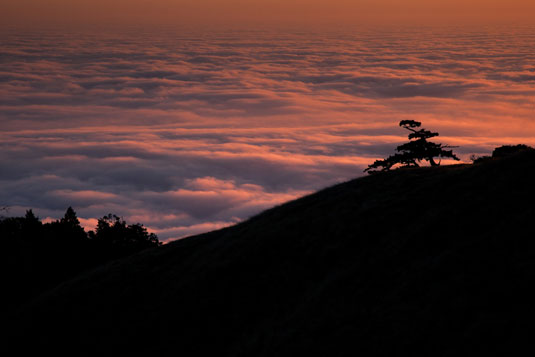Late afternoon sun is ideal for landscape photography. The quality of the light changes as the sun sinks lower in the sky. When photographing nature and you come upon a scene you like, take several pictures of it as the light changes in the late afternoon.
When you’re an hour from sunset (Golden Hour), the quality of the light changes quickly. This is when the shadows start to get longer and the colors of the landscape get warmer. The long soft shadows add drama to your pictures. If you’re photographing mountains, the warm colors bring life to the scene.
Most photographers look toward the sun for their subject matter when photographing in the late afternoon. If you fall into this category, try turning around and look at the wonderful golden light that falls on the landscape and subjects.
If you use a wide-angle focal length with a small aperture and the sun is in your scene, the sun looks like a star. You see more spikes on the star when you shoot with a smaller aperture.
When you shoot directly into the sun using a lens with a wide-angle focal length, the sun is small in relation to the rest of what’s in your viewfinder. The sun will still be overexposed, but it won’t be a glaring highlight.
Late afternoon sun is also great for creating silhouettes. Trees with graceful draping branches are wonderful subjects for silhouettes. If the trees are draped with moss, you can capture a dramatic picture. When your goal is to create a silhouette, use exposure compensation to ensure that the silhouettes are a rich dark black (see the figure). Start with –2/3 EV and review your image.
If the silhouettes aren’t dark enough, decrease the exposure even more. When you decrease the exposure, the colors of the sky become richly saturated. It’s okay to radically underexpose an image when you’re shooting a silhouette. When shooting a silhouette, make sure you don’t have a prominent object in the background that is also in silhouette. This detracts the viewer’s attention from your subject matter.

If clouds are in the sky, don’t put your gear away after the sun sinks below the horizon. As long as the clouds don’t go all the way to the horizon, the sun still illuminates the underside of them. The clouds will be orange right after the sun goes down.
A minute or two later they turn deep pink and about ten minutes after the sunset, they’ll turn a deep purple. This is also a wonderful time to create photos with dramatic silhouettes.
When planning a photo shoot, it’s a good idea to find out the exact time of the sunrise or sunset and the location of the sun at any time during the day. You can easily accomplish this task using an application called The Photographer’s Ephemeris (TPE).
The application is free for desktop computers and is available as a paid application for mobile devices like the iPhone and will become available at a later date for Android. The application enables you to plot the exact location of your photo shoot. Enter the date, and you can plot the path of the sun in relation to the area you’re photographing.

